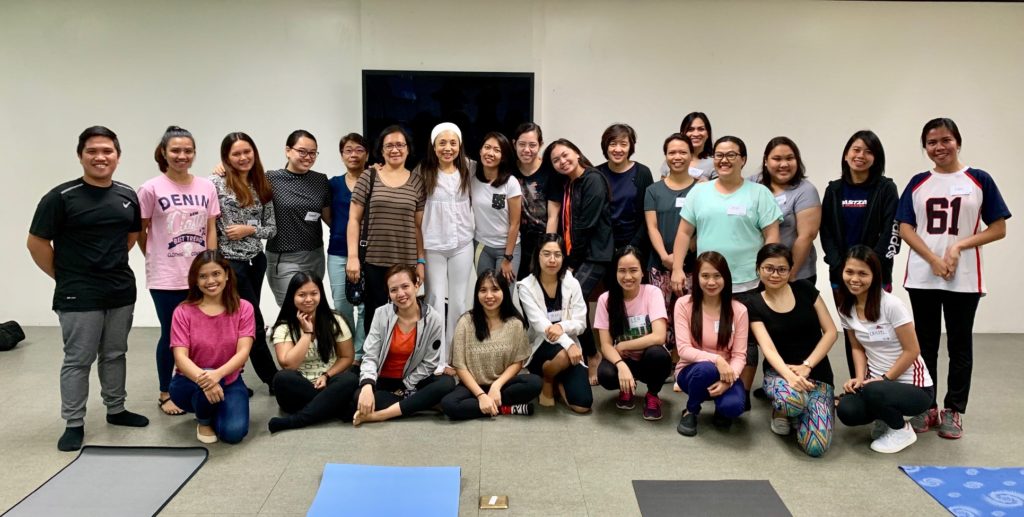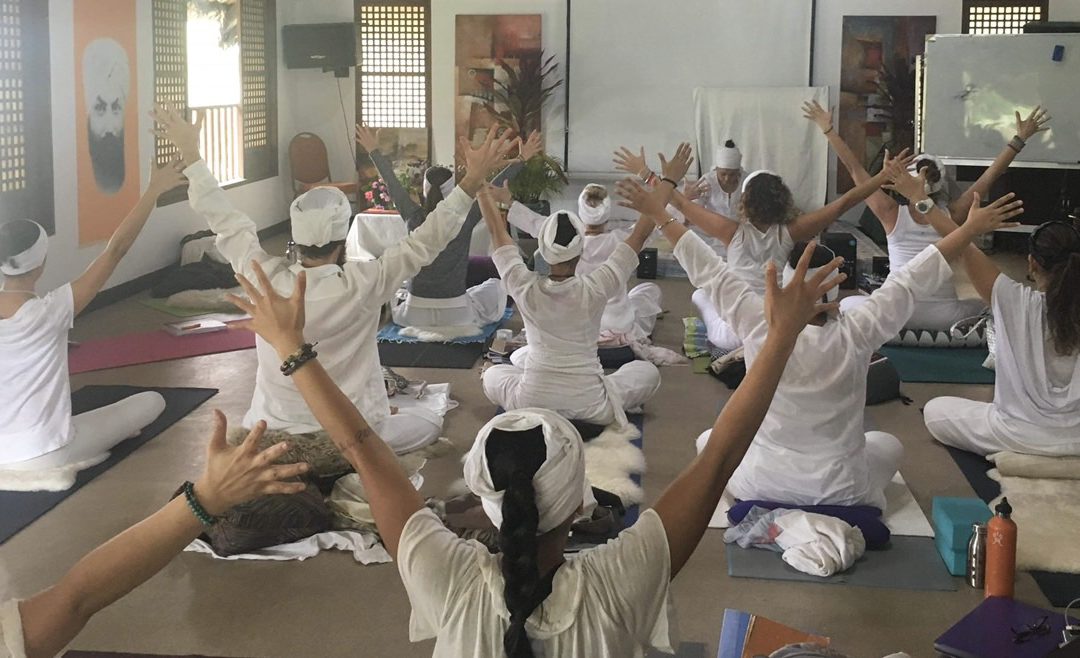In my Kundalini Yoga classes I always encourage the students to meditate regularly and if possible, to do the meditation taught in class for at least one week as homework. Ideally, it would be good to do the meditation for 40 days for it takes this time to make a habit. After all, our habits define us.
The American Journal of Psychology defines a habit as, “A fixed way of thinking, willing, or feeling acquired through previous repetition of a mental experience.” A habit can create peace and happiness or misery and pain. It is said that when we change our habits, we can change everything around us.

at ChinaBank’s Work-Life Integration Program
The best way to break a habit is to sit and meditate.
I’ve been teaching a workshop called “Meditate like a Yogi” and this morning, I taught the same workshop to a group of 25 office people from ChinaBank as part of their Work Life Integration Program. This is one of their wellness offerings to help reduce stress and improve the wellbeing of their employees.
Meditation is a practice to train attention and awareness to achieve a mentally clear and emotionally calm and stable state. It’s a myth to think that when you sit down to meditate, you will be able to immediately quiet the mind. The mind generates a thousand of thoughts per blink of an eye. When you sit quietly and turn the focus inward, you become very aware of what is going on in your mind. All sorts of things come up and whatever comes up, you stay with the experience which can either be comfortable and pleasing or disturbing and painful.
As you are able to sit and let go of judgements and stay with the experience, you become more able to persevere through all kinds of circumstances, outside your meditation. You begin to form a nonjudgemental, unbiased clarity of just seeing. You begin to see your judgements, the habitual patterns that limit your life, and defence mechanisms.
Meditation purifies the mind. It is the process of cleansing the mind, clearing out old subconscious garbage. Yogi Bjhajan had said, “At any time which is peaceful, you’ll be surprised that in a couple of minutes, you may find yourself observing some very unpleasant, ugly thoughts while you’re meditating. If you let those thoughts pass by, this is meditation.”
I’m sharing some tips to prepare you for meditation.
If you want to a meditation for yourself to address a specific issue, please message me.
1. Choose a quiet space
Choose a place where you won’t be disturbed or get distracted. Try to use the same place each time. Sit on a sheepskin, a natural fiber blanket or a firm cushion. If you cannot sit comfortably on the floor, sit in a chair.
2. Choose when to meditate
Try to keep the same time every day. The amrit vela or 2.5 hours before sunrise is highly recommended because it sets you for the whole day and is naturally a quiet, reflective time. At sunset from 4 to 7 pm is also ideal as well as before bedtime, to help you settle and clear the mind in preparation for sleep.
3. Commit to a meditation for a length of time
Choose a meditation that you can do for a number of days. It takes 40 days to change a habit, 90 days to confirm a positive habit, 120 days to become the new habit and 1,000 days to master the new habit. Try to take it slow. It’s better to do sit in meditation for at least 3 minutes each day than doing 31 minutes once a week. According to Yogic Science, it takes 3 minutes to affect the blood circulation and electromagnetic field. 11 minutes to change the glandular system and nerves. 22 minutes to balance and coordinate the three minds (negative, positive and neutral). 31 minutes to affect all the cells and rhythms of the body and all layers of the mind’s projection. And 62 minutes will change the brain’s gray matter and integrate the subconscious “shadow mind” and the outer projection. You can extend to 2.5 hours which will hold the new pattern in the subconscious mind by the surrounding universal mind.
4. Tune-in with Ong Namo Guru Dev Namo
Do chant the Adi Mantra, Ong Namo Guru Dev Namo three times before beginning the meditation. You can also choose to do a yoga kriya or some warm-ups after tuning in.
5. Keep the Spine Straight
It is important to keep the spine straight and the posture balanced. The spine acts as a central channel for the energy of the nervous system.
Deepen your journey with Kundalini Yoga
Join us for the Kundalini Yoga Level One Teacher Training? We have an early bird rate until July 1. You don’t even have to teach after the course, you can use it to deepen your practice and help you develop the steadiness, grace and self-confidence to make a difference in yourself and the world around you!
May you take this, or the many other opportunities out there to bloom. And as always, do away with things that do not serve you.
In loving service,
Rosan



Trackbacks/Pingbacks